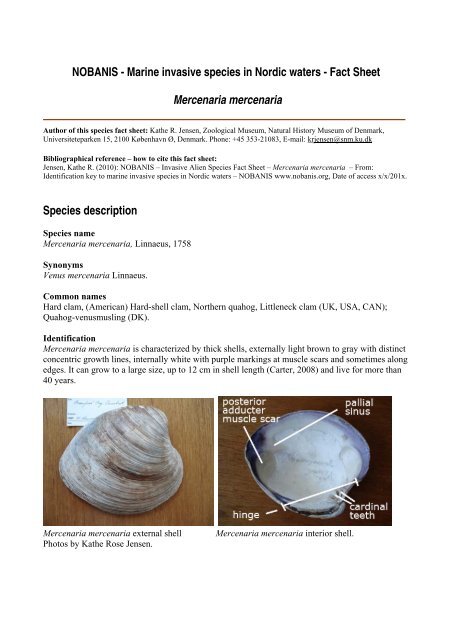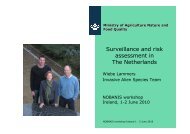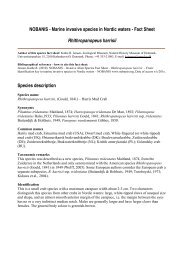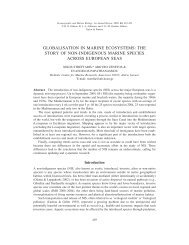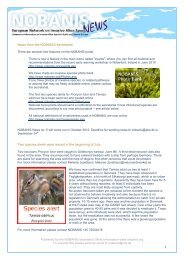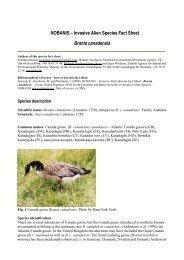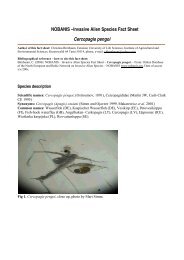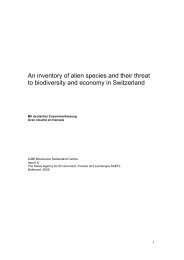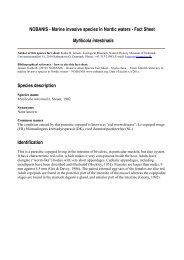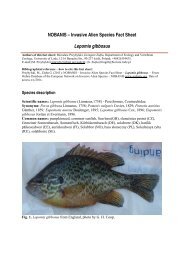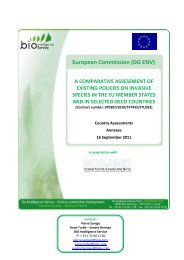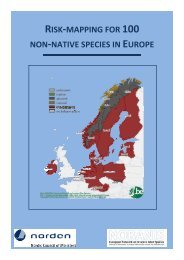Mercenaria mercenaria - NOBANIS
Mercenaria mercenaria - NOBANIS
Mercenaria mercenaria - NOBANIS
Create successful ePaper yourself
Turn your PDF publications into a flip-book with our unique Google optimized e-Paper software.
<strong>NOBANIS</strong> - Marine invasive species in Nordic waters - Fact Sheet<br />
<strong>Mercenaria</strong> <strong>mercenaria</strong><br />
Author of this species fact sheet: Kathe R. Jensen, Zoological Museum, Natural History Museum of Denmark,<br />
Universiteteparken 15, 2100 København Ø, Denmark. Phone: +45 353-21083, E-mail: krjensen@snm.ku.dk<br />
Bibliographical reference – how to cite this fact sheet:<br />
Jensen, Kathe R. (2010): <strong>NOBANIS</strong> – Invasive Alien Species Fact Sheet – <strong>Mercenaria</strong> <strong>mercenaria</strong> – From:<br />
Identification key to marine invasive species in Nordic waters – <strong>NOBANIS</strong> www.nobanis.org, Date of access x/x/201x.<br />
Species description<br />
Species name<br />
<strong>Mercenaria</strong> <strong>mercenaria</strong>, Linnaeus, 1758<br />
Synonyms<br />
Venus <strong>mercenaria</strong> Linnaeus.<br />
Common names<br />
Hard clam, (American) Hard-shell clam, Northern quahog, Littleneck clam (UK, USA, CAN);<br />
Quahog-venusmusling (DK).<br />
Identification<br />
<strong>Mercenaria</strong> <strong>mercenaria</strong> is characterized by thick shells, externally light brown to gray with distinct<br />
concentric growth lines, internally white with purple markings at muscle scars and sometimes along<br />
edges. It can grow to a large size, up to 12 cm in shell length (Carter, 2008) and live for more than<br />
40 years.<br />
<strong>Mercenaria</strong> <strong>mercenaria</strong> external shell <strong>Mercenaria</strong> <strong>mercenaria</strong> interior shell.<br />
Photos by Kathe Rose Jensen.
Distribution<br />
Native area<br />
East coast of North America from the Gulf of St. Lawrence to Florida.<br />
Introduced area<br />
<strong>Mercenaria</strong> <strong>mercenaria</strong> was first introduced to the Atlantic coast of France in 1861 (Goulletquer et<br />
al., 2002) and is presently established in the wild in Brittany. It has also been introduced for<br />
aquaculture several times in the UK. The first successful introduction was in 1925 (Carter, 2008).<br />
Wild populations were first recorded around 1960 (Heppell, 1961). Presently it has a restricted<br />
distribution (Carter, 2008). It has been found on several occasions in the Netherlands and Belgium,<br />
probably accidentally introduced with oysters from France (Wolff, 2005), but apparently it is not<br />
reproducing in the wild. It has also been introduced to the west coast of the USA, the Mediterranean<br />
and China.<br />
Vector<br />
Although introduction for aquaculture has been made on several occasions, accidental introduction<br />
associated with oysters or from the kitchens of vessels is considered more likely as the vector in the<br />
UK (Ansell, 1963). Secondary dispersal from populations in France has also been suggested<br />
(Heppell, 1961).<br />
Ecology<br />
<strong>Mercenaria</strong> <strong>mercenaria</strong> is often found associated with oyster reefs or seagrass beds. It is relatively<br />
euryhaline, tolerating from 4 to 35ppt, though growth is fastest between 24 and 28ppt. It tolerates<br />
temperatures ranging from -2° C to 35° C. Growth is reduced at temperatures below 10° C and<br />
ceases below 5° C. It lives in muddy sediment in shallow water<br />
Reproduction<br />
The first wild-caught <strong>Mercenaria</strong> <strong>mercenaria</strong> in the UK spawned at about 18° C, though in its<br />
native area the minimum temperature for spawning was said to be 23° C (Ansell, 1963). In the<br />
laboratory larval development took about 2 weeks at 20° C. Sexual maturity usually reached at a<br />
shell length of 35mm.<br />
Impacts<br />
In its native area there is an important fishery for <strong>Mercenaria</strong> <strong>mercenaria</strong> (Peterson, 2002). Smaller<br />
specimens have higher value than large ones, which negatively influences reproduction and<br />
recruitment. In Europe no effects on ecosystems or native species have been recorded. Effects of<br />
fishery are the same as for other clams dredged with mechanical or hydraulic clam dredges.
References<br />
Ansell, A.D. 1963. Venus <strong>mercenaria</strong> (L) in Southhampton Water. Ecology 44(2): 396-397.<br />
Ansell, A.D. 1968. The rate of growth of the hard clam <strong>Mercenaria</strong> <strong>mercenaria</strong> (L) throughout the geographical range.<br />
Journal du Conseil Int. Explor. Mer 31(3): 364-409.<br />
Ansell. A.D., Lander, K.F., Coughlan, J. and Loosmore, F.A. 1964. Studies on the hard-shell clam, Venus <strong>mercenaria</strong>,<br />
in British waters. I. Growth and reproduction in natural and experimental colonies. Journal of Applied Ecology 1(1):<br />
63-82.<br />
Ansell, A.D., Loosmore, F.A. and Lander, K.F. 1964. Studies on the hard-shell clam, Venus <strong>mercenaria</strong>, in British<br />
waters. II. Seasonal cycle in condition and biochemical composition. Journal of Applied Ecology 1(1): 83-95.<br />
Carter, M.C. 2008. <strong>Mercenaria</strong> <strong>mercenaria</strong>. Hard-shell clam. Marine Life Information Network: Biology and<br />
Sensitivity Key Information Sub-programme. Avaiable here (accessed 5 August, 2009).<br />
Goulletquer, P., Bachelet, G., Sauriau, P.G. and Noel, P. 2002. Open Atlantic coast of Europe – a century of introduced<br />
species into French waters. In: Invasive aquatic species of Europe. Distribution, impacts and management (eds. E.<br />
Leppäkoski, S. Gollasch and S. Olenin), pp. 276-290. Kluwer Academic Publishers, Dordrecht, The Netherlands.<br />
Heppell, D. 1961. The naturalization in Europe of the quahog, <strong>Mercenaria</strong> <strong>mercenaria</strong> (L.). Journal of Conchology 25:<br />
21-34.<br />
Murphy, R.C. 1985. Factors affecting the distribution of the introduced bivalve, <strong>Mercenaria</strong> <strong>mercenaria</strong>, in a California<br />
lagoon – The importance of bioturbation. Journa of Marine Research 43: 673-692.<br />
Peterson, C.H. 2002. Recruitment overfishing in a bivalve mollusc fishery: hard clams (<strong>Mercenaria</strong> <strong>mercenaria</strong>) in<br />
North Carolina. Canadian Journal of Fisheries and Aquatic Sciences 59: 96-104.<br />
Wolff, W.J. 2005. Non-indigenous marine and estuarine species in The Netherlands. Zoologische Mededelingen 79(1):<br />
1-116.


